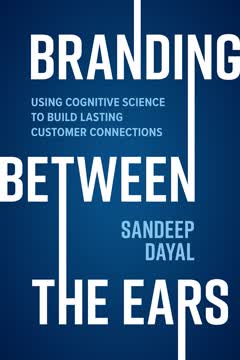重点摘要
1. 认知品牌的运作方式与大脑相似,利用潜意识决策
认知品牌是解锁我们大脑中存储的体验和幻想感受的钥匙,使我们更快乐并吸引我们到品牌。
大脑与品牌的对齐。 认知品牌利用神经科学和心理学的最新进展,设计出与人类大脑实际处理信息和做出决策方式相似的品牌体验。这种方法认识到多达95%的消费者选择是潜意识驱动的,由心理捷径和情感联想而非纯粹的理性思考所推动。
关键大脑过程。 认知品牌框架关注大脑的四个主要功能子单元:
- 联想器:利用过去的经验做出快速、直观的判断
- 深思者:在需要时进行更费力的分析性思考
- 学习者:不断编码和更新与品牌相关的记忆和联想
- 动机器:基于预期的幸福感和个人目标驱动动机和行动
通过将品牌策略与这些自然的认知过程对齐,营销人员可以创造出更具吸引力和记忆点的品牌体验,在意识和潜意识层面上深深打动消费者。
2. 品牌氛围与消费者建立情感联系和共同价值观
品牌氛围是契约,而不是幻想。背叛与客户建立的信任的品牌会发现自己陷入无法自拔的困境。
情感共鸣。 品牌氛围是品牌与消费者形成的初步情感联系,为更深入的互动奠定基础。这些氛围可以通过两种主要方式创建:
- 共同感受:展示对消费者体验的同理心和理解
- 共同价值观:将品牌与目标受众重要的事业或原则对齐
建立信任。 有效的品牌氛围通过以下方式建立信任:
- 承认消费者的痛点或愿望
- 展示对共同价值观的真实承诺
- 创造一种亲密感或归属感
强大品牌氛围的例子:
- 斯巴鲁对LGBTQ+社区的微妙信息传递
- 本&杰瑞对社会正义事业的承诺
- 耐克与科林·卡佩尼克的合作
通过建立这些情感联系,品牌使消费者更容易接受其核心价值主张和信息。
3. 系统1简化器使品牌选择变得本能且轻松
系统1简化器旨在引导消费者本能地理解品牌主张,顺其自然而不是与之抗争。
认知轻松。 系统1简化器利用大脑对快速、低努力决策的偏好。它们使品牌选择感觉:
- 熟悉
- 真实且可信
- 良好
- 轻松
关键认知偏差。 营销人员可以利用几种认知偏差来创建系统1简化器:
- 锚定偏差:提供比较的参考点
- 损失厌恶:强调潜在损失而非收益
- 内群体偏差:创造归属感或身份认同
- 选择支持偏差:强化过去选择的积极面
有效系统1简化器的例子:
- DiGiorno的“这不是外卖,这是DiGiorno”广告
- RxBar在包装上透明的成分列表
- Staples的“Easy Button”概念
通过与这些自然的心理捷径对齐,品牌可以成为消费者本能的、低努力的选择。
4. 系统2深思者通过复杂品牌决策进行有意识的推理
系统2深思者有其他特点。由于它们需要脑力劳动,除非必要,否则不会启动。
有意识的评估。 当消费者需要做出更复杂或高风险的品牌决策时,系统2深思者会被激活。它们通过以下方式工作:
- 放大感知价值
- 降低感知风险
- 提供可信的理由
- 重构决策的背景
认知行为疗法的启发。 作者将系统2深思者与认知行为疗法中用于改变思维模式的技术进行比较:
- 无脑方法:使价值主张极具吸引力
- 快乐预测:生动地描绘潜在的积极结果
- 战斗或逃跑:正面解决恐惧或担忧
- 调情训练:允许低承诺的试用体验
有效系统2深思者的例子:
- Uber最初的便利性和成本节约价值主张
- Warby Parker的在家试戴计划
- 百达翡丽将手表重新定位为家族传承
通过激活系统2过程,品牌可以克服初步的犹豫,尤其是在高参与度的购买中建立更持久的忠诚度。
5. 品牌决心通过与消费者的幸福追求对齐来激励他们采取行动
在消费者追求幸福的过程中找到帮助他们的方法的品牌会更受欢迎和喜爱。
幸福驱动因素。 品牌决心通过解决三大核心内在动机来利用人类普遍的幸福追求:
- 自主需求:感觉自己掌控选择和命运
- 能力需求:掌握技能并感觉有能力
- 关系需求:与他人联系并成为更大事物的一部分
动机能量。 不同的消费者在追求这些需求方面有不同的倾向,这影响了他们的品牌偏好和行为。营销人员可以使用基于倾向的消费者细分来针对最合适的受众,提供最具吸引力的幸福主张。
有效品牌决心策略的例子:
- National Car Rental的“Go Like a Pro”广告(自主)
- Mastercard的“无价”广告(关系)
- PediaSure定位为帮助孩子“成长为他们能成为的一切”(能力)
通过将品牌定位为解锁特定幸福形式的钥匙,营销人员可以在消费者中创造更强的决心来选择并坚持他们的产品或服务。
6. 有效的品牌执行考虑大脑如何处理和记住体验
品牌印象仅基于整个品牌体验的一小部分,即高潮和结尾。
选择性记忆。 大脑不会平等地处理或记住品牌体验的所有方面。有效执行的关键原则包括:
- 高峰-终点规则:专注于创造难忘的高点和强烈的结尾
- 新奇偏差:意外元素更容易被注意和记住
- 基于故事的回忆:叙述比事实或利益列表更容易记住
- 多感官参与:涉及多个感官创造更强大、更全面的记忆
执行策略:
- 在感官接触点(视觉、听觉、嗅觉等)创建独特的“品牌签名”
- 使用讲故事使品牌利益更容易记住和相关
- 通过意外的积极体验给客户带来惊喜和愉悦
- 确保品牌互动的高潮和结尾特别积极
有效感官品牌的例子:
- 新加坡航空在整个飞行体验中使用的定制香氛
- Burberry独特的视觉图案和店内香氛
- John West意外且幽默的“熊打架”广告
通过将品牌执行与大脑自然处理和记住信息的方式对齐,营销人员可以创造更有影响力和持久的品牌印象。
7. 道德认知品牌尊重消费者自主权和社会福祉
仅仅因为你能做,是否应该做?
道德考量。 随着认知品牌技术变得越来越复杂,营销人员必须考虑其策略的道德影响。关键的道德测试包括:
- 规范性命令:你希望别人这样对你吗?
- 类别命令:如果每个人都这样做会好吗?
- 阳光命令:如果这个策略被公开,你会感到舒服吗?
潜在陷阱:
- 用户界面中的操纵性黑暗模式
- 利用认知偏差驱动过度消费
- 通过潜意识暗示误导产品利益
负责任的做法:
- 营销声明和定价的透明度
- 将品牌目标与真正的社会利益对齐
- 尊重消费者隐私和数据自主权
- 赋予知情决策的权力
通过遵守道德原则,认知品牌可以创造双赢的结果,既有利于品牌,也有利于消费者,同时对社会做出积极贡献。
最后更新日期:
FAQ
What's Branding Between the Ears about?
- Cognitive Science Application: The book delves into how cognitive science principles can be applied to branding, focusing on psychological triggers that make brands resonate with consumers.
- Cognitive Branding Model: It introduces "cognitive brands," which are designed to align with the brain's natural processes, emphasizing elements like good vibes, sense, and resolve.
- Practical Insights: The author provides actionable frameworks and real-world examples for marketers to create brands that connect deeply with consumers.
Why should I read Branding Between the Ears?
- Transformative Perspective: The book offers a fresh take on branding by integrating neuroscience and psychology, moving beyond traditional methods.
- Actionable Strategies: Readers gain practical tools and frameworks that can be immediately applied to enhance branding efforts.
- Credible Resource: Endorsed by industry leaders, it serves as a reliable guide for marketers aiming to innovate and connect with consumers.
What are the key takeaways of Branding Between the Ears?
- Cognitive Brands: Successful brands align with how the brain processes information, focusing on emotional and psychological connections.
- Three Elements: The book highlights brand vibes (empathy), brand sense (making sense of choices), and brand resolve (motivating purchases) as key components.
- Behavioral Insights: Understanding consumer behavior through cognitive biases is crucial for effective branding strategies.
What is the concept of "cognitive branding" in Branding Between the Ears?
- Definition: Cognitive branding involves designing brands that resonate with the brain's natural processes, making them more appealing and memorable.
- Three Components: It includes brand vibes (emotional connection), brand sense (intuitive understanding), and brand resolve (motivation to purchase).
- Practical Framework: The book provides a framework for marketers to create cognitive brands by leveraging consumer psychology.
How does Branding Between the Ears define "brand vibes"?
- Emotional Connection: Brand vibes are the emotional bonds that brands create with consumers, making them feel understood and valued.
- Empathy and Trust: Establishing good vibes involves showing empathy towards consumer experiences and aligning with their values, fostering trust.
- Foundation for Value Proposition: Good brand vibes set the stage for consumers to accept and embrace the main brand message more readily.
What are "System 1 Easers" and how do they work in branding according to Branding Between the Ears?
- Definition: System 1 Easers are elements that help consumers make intuitive and instinctive choices about brands without deep deliberation.
- Cognitive Ease: They create a sense of familiarity, truth, goodness, or ease, making the brand choice feel effortless and natural.
- Examples: Techniques like anchoring bias and loss aversion bias are used to align brand messages with consumers' existing beliefs and preferences.
How does Branding Between the Ears suggest using "System 2 Deliberators" in branding?
- Analytical Thinking: System 2 Deliberators engage consumers in logical reasoning, helping them evaluate the brand's value proposition critically.
- Four Strategies: The book outlines strategies like amplifying value, lowering risk, providing reasons to believe, and framing the brand choice favorably.
- Consumer Empowerment: These strategies help consumers feel more confident in their decisions, leading to stronger brand loyalty.
What role does emotional branding play in Branding Between the Ears?
- Emotional Resonance: Emotional branding is crucial for creating connections that resonate with consumers on a deeper level, influencing their perceptions and choices.
- Risk of Overemphasis: The book warns that overly emotional branding can overshadow the brand itself, leading to poor recall of the brand name.
- Balanced Approach: Successful branding should balance emotional appeal with clear brand messaging to ensure consumers remember both the feelings and the brand.
How can brands create a sense of "resolve" according to Branding Between the Ears?
- Motivation to Act: Brand resolve is about encouraging consumers to take action and make a purchase by linking the brand to their happiness and goals.
- Personal Connection: Brands should resonate with consumers' aspirations and values, making them feel that purchasing the brand will enhance their lives.
- Overcoming Indecision: By addressing consumer hesitations and providing compelling reasons to buy, brands can effectively motivate consumers to choose their products.
How does Branding Between the Ears define happiness in the context of branding?
- Happiness as a Goal: The author states that "all consumers pursue happiness as a conscious or subconscious goal," central to their decision-making.
- Neurochemical Basis: Happiness is linked to the release of specific brain chemicals (dopamine, oxytocin, serotonin, and endorphins) that brands can trigger through positive experiences.
- Anticipatory vs. Consummatory Pleasures: The book differentiates between anticipatory pleasures (imagining future happiness) and consummatory pleasures (experiencing happiness), both of which brands can leverage.
What are some examples of successful brands mentioned in Branding Between the Ears?
- PediaSure: Successfully repositioned from a hospital product to a household brand by addressing parents' concerns about children's nutrition.
- Mastercard: The "Priceless" campaign effectively connected emotional experiences with its brand, enhancing consumer loyalty.
- National Car Rental: The "Go Like a Pro" campaign targeted frequent business travelers by appealing to their need for autonomy and control.
What ethical considerations does Branding Between the Ears address?
- Manipulation vs. Influence: The author warns against using cognitive branding techniques to manipulate consumers in ways that could harm their well-being or financial stability.
- Three Ethical Tests: Introduces the Canonical Imperative, Categorical Imperative, and Sunshine Imperative to help marketers evaluate their strategies.
- Responsibility in Marketing: Marketers are encouraged to use their knowledge of cognitive science responsibly, ensuring that their branding efforts benefit consumers rather than exploit them.
评论
《耳边的品牌》获得了大多数正面评价,读者们称赞其对认知科学和营销策略的深刻见解。许多人认为这本书对于理解品牌如何利用脑科学来建立持久的客户联系非常有价值。该书因其清晰的结构、最新的实例和实用的建议而备受推崇。一些读者欣赏作者的幽默感和对复杂概念的通俗解释。然而,也有少数评论者指出,这本书可能需要集中注意力,并包含大量制药行业的例子。
Similar Books













